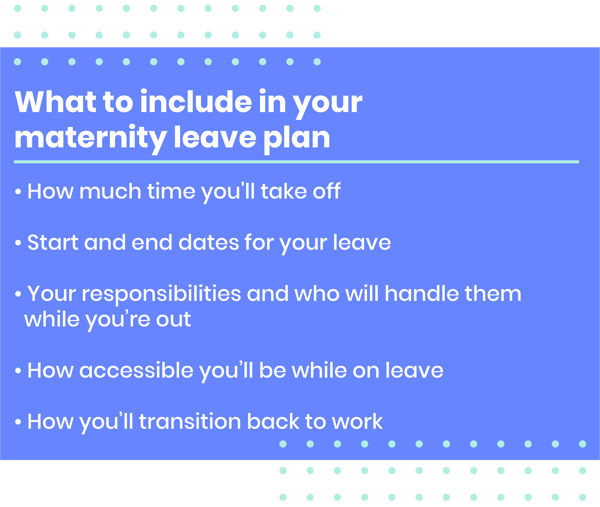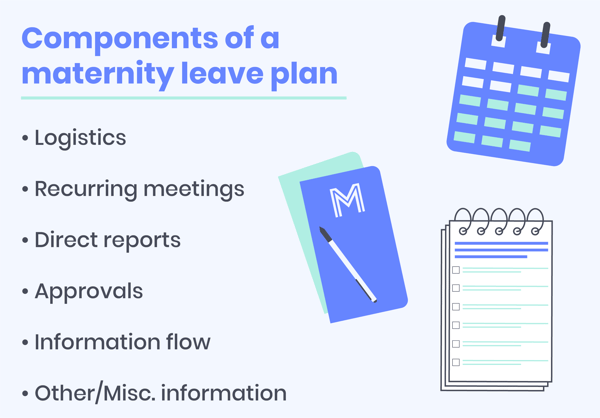Keep in mind these three key phases of a maternity leave plan.
Planning for maternity leave can feel daunting, but it doesn’t have to be an overwhelming endeavor! By breaking down your maternity leave into three separate timelines you can make the planning effort feel more manageable.
Below we’ll cover each of these three phases and what they entail:
- Before Your Departure
- The Time During Your Leave
- Your Return to Work
Beyond that, a comprehensive maternity leave plan needs to include details around the following, at a minimum:
- Your responsibilities at the office
- How you want your leave to be handled
- How you want your transition back to work to be managed
Read on for more details about appropriately planning for your maternity leave.
Phase 1: Gather information for your maternity leave
* Generally recommended timeline: the first trimester of pregnancy
Start off on the right foot by knowing your rights. Look into general maternity leave rights and laws by reading up on the Family and Medical Leave Act (FMLA), short-term disability and your state’s laws as well. State laws do vary so be sure to look at the ones specific to where you live.
You’ll also want to look at your own company’s policies. You can find out this information by talking with an HR rep or looking in an employee handbook. Be aware that you may have paperwork or forms to fill out for benefits at the federal, state and/or company level.
▶️ Watch: Unity Hour - Mothers' Rights at Work featuring "The Mamattorney" Daphne Delvaux for more information on how to detect discrimination, frame communications with management during a conflict and how to request accommodations before, during and after maternity leave
You’ll also want to talk with your boss as soon as you are comfortable doing so. Keep in mind that as soon as you tell one person you should assume the cat is out of the bag and your boss will know soon if you haven’t told him or her. This initial conversation should be one of many that you have in preparation for your maternity leave. And approach it with your best foot forward. This is joyful, exciting news and should be delivered as such. Know that what you say and how you say it will influence people’s response to your news.
Talk with a trusted colleague or friend that has recently gone on maternity leave, or had someone on their team do so. Ask for advice on how they planned, what they would have changed and any other feedback they can provide. Feel free to talk with more than one person if you can to get a variety of input.
📖 Read more: Determining When to Disclose Your Pregnancy at Work
Look at your own assets
Crunch the numbers to see how much leave (paid and/or unpaid) you can afford to take. Make sure you understand how the leave will affect other parts of your compensation package. For example, will your maternity leave affect your health insurance, vacation day accrual or anything else? It’s better to plan up front for these than to be surprised by them when you are busy enjoying your time with a newborn.
Phase 2: Create your maternity leave plan
* Generally recommended timeline: the second trimester of pregnancy
 Determine how much time you plan to take off
Determine how much time you plan to take off
After you’ve gathered your information you’ll want to start creating your maternity leave plan.
The first thing to decide is how much time you’d like to take off. Using your information from above, you’ll want to consider how much time your company can offer you, how much you can afford and how much you’ll need to recover. Every birth is different, but many new moms need about six weeks to fully recover from the physical effects of giving birth.
You’ll also need to factor in sleep-deprivation as it can take another two to three months before you start getting a 4-hour stretch of sleep at night. True, some babies sleep five or six hours at a time when they are younger, but many don’t until they are eight months or older.
You can then provide expected maternity leave dates and your expected return date based on how long you plan to be out. Some mothers will want to work right up until the last day before giving birth while others would like to take some time off before the baby comes. Whichever you decide, be sure to keep your final week at work mostly open for any last-minute tasks and to provide a buffer if needed.
Be upfront about your accessibility
You’ll also want to determine how accessible you’ll be while you’re out and communicate that clearly. Create a communication plan with your office and colleagues that outlines whether you plan to check-in, and if so when you will check-in.
Every mother is different. Some relish the idea of being completely offline for months while others break out in a sweat at the idea of not reading emails for a day. There is no wrong answer so pick the one that works best for you and your team!
You may also want to consider designating someone at work you trust to keep you in the loop so you can disconnect totally but know you have a line to the office if anything big should change while you are out.
Who is responsible for your responsibilities?
Next, think about all the bits and pieces of your role and what your job entails. You’ll want to document your processes, projects and priorities. And then, if it seems reasonable, add in who you would suggest to handle your various responsibilities while you are out. Discuss this potential coverage with your supervisor. And don’t forget to plan for supervision and mentoring of any direct reports you have yourself.
👉 A good rule of thumb is to transfer direct reports to their interim managers one to two weeks out to help ease the transition.
One last note, don’t assume everyone will be eager to take on additional responsibilities. Be clear and concise and explain why you think certain tasks are important and why you believe a specific colleague is well-suited for covering the task at hand.
The Transition Back
Your maternity leave plan should also include information on how you will transition back into your role and the office. This is the time to explore phased-in reentry or flexible work options for your return if you are interested in that. If you are considering working on a part-time basis or asking for a flexible schedule or remote work options, include that in your conversations now so there aren’t any surprises during your transition back into work.
If there is an option to ease back into the role, you should also consider how much you plan to work in your first few weeks back on the job. Not all companies can be flexible, but if this is something you are interested in, it is better to ask up front so everyone’s expectations can be realistic as your maternity leave comes to an end.
Phase 3: Deliver your maternity leave plan
* Generally recommended timeline: End of the second or beginning of the trimester of pregnancy
Create a physical document you can share
Your maternity leave document can be something shared in Google drive, an email or a hardcopy binder. The delivery isn’t as important as the contents.

And your Maternity Leave Plan document should include the following:
The logistics
- Your due date
- Your last day in the office
- Your last day of work
- Your length of leave
- Contact information for your doctor and hospital in case of emergency
Recurring meetings
- Meetings you lead with who will run them in your place
- Meetings you participate in, with anyone taking your place as necessary
- Meetings that will be canceled while you are out
- Who will they report to in your absence
- How often you meet with them
- Any relevant performance note
- If anyone else will be supporting them as well
- List of things you approve regularly
- List of tasks you do regularly (e.g., signing contracts)
- Who will handle them in your absence
- A shortlist of important things you would like updates on (if any)
- Topics you’d like to continue being cc’d on while you are out so you can catch up when you are back
- Any other miscellaneous information you can think of. It is better to overshare rather than leave anyone wondering.
Other Items
Be sure to set up official meetings with anyone that may be impacted by your maternity leave whether it’s your manager, co-workers or direct reports. You’ll want to carve out dedicated time to teach those covering for you about what they’ll need to do in your absence and introduce them to any key contacts if necessary.
You’ll also need to make sure you communicate your maternity leave with any outside clients or contacts. You should schedule a time for them to meet with the person or people covering for you while you are gone. Introduce the two parties while you are still in the office to help allow them to slowly begin working together. This way, you can iron out any kinks and ensure that everyone has a good experience in your absence.
You may even want to consider creating a client maternity leave email that includes:
- How many weeks you'll be out of the office
- When you will leave the office
- When you will return to the office
- Who they can contact for support while you are out
- That you'll be unavailable while on leave
You should view this letter as an expectation setting with your client and contacts so they don’t feel at a loss while you are out of reach.
Beyond your maternity leave plan
Even the best-laid plans can go awry. Be prepared for surprises when it comes to maternity leave. Things happen. A baby could come early or late, or you could have unexpected complications. You should create an if-I-go-into-labor-at-work document with information about where you plan to deliver, the phone number of your OB-GYN, doula, midwife, etc. and emergency contact numbers, and share it with a few trusted colleagues just to be safe.
It’s also important to set boundaries and expectations for your maternity leave and then to stand by them. This time is a special time for you and your baby and you’ll need the recovery time.
Set the future you up for success
- Block out pumping times, if applicable, on your calendar before you leave for when you return.
- Set up a clear out of office message
- Unsubscribe from any regular newsletters or e-mail lists that you're on. (Make sure to keep notes, so you can re-subscribe when you come back to work)
- Explore childcare options. Many have long, long waitlists. Check into your options before the baby comes so you aren’t scrambling.
- Avoid overcommitting. Do not make to-do lists for during your maternity leave.
- Document everything. Create a physical and digital folder for all your maternity leave related documents. In this folder, you can put any HR forms, state disability application forms, insurance forms, benefits information, emails from HR or your manager pertaining to your leave, and other related information. Make copies of anything you fill out and send in as well.
📖 Read more: How to Prepare for Your Return from Maternity Leave
There is a lot that goes into creating a successful maternity leave plan as well as having a successful maternity leave. The good news is you have nine months to get everything in order and, if you tackle it little by little, you’ll be set up for enjoying maximum snuggle time with your little one when they arrive.
Join a community that cares
Join our talented community of moms and mom allies. Whether you’re searching for your next opportunity, looking to give or get career guidance or just getting started—you’re in the right place. 



